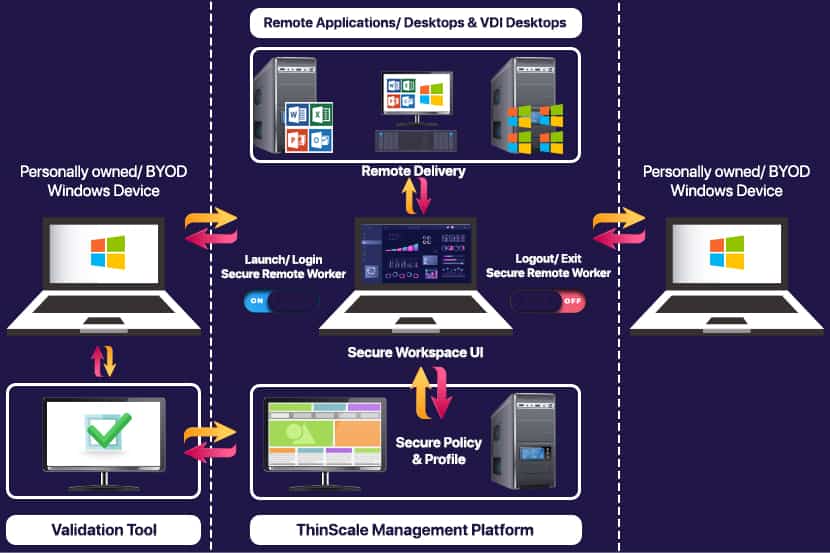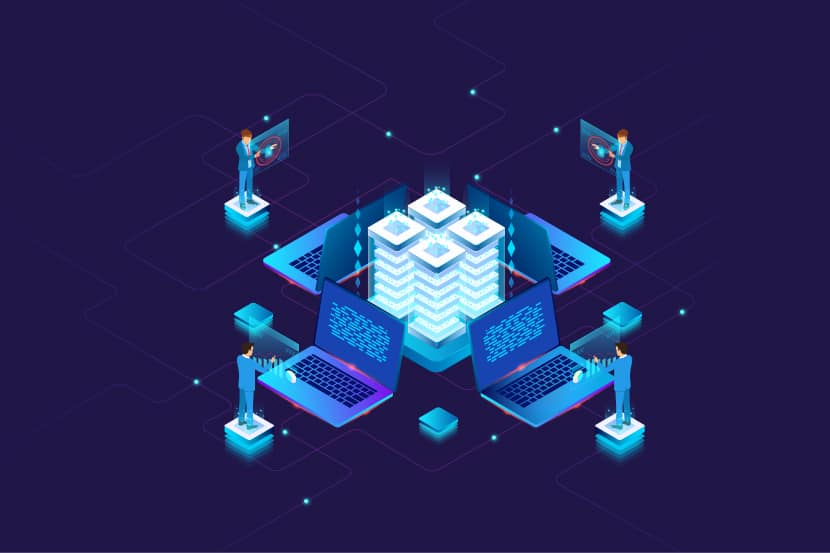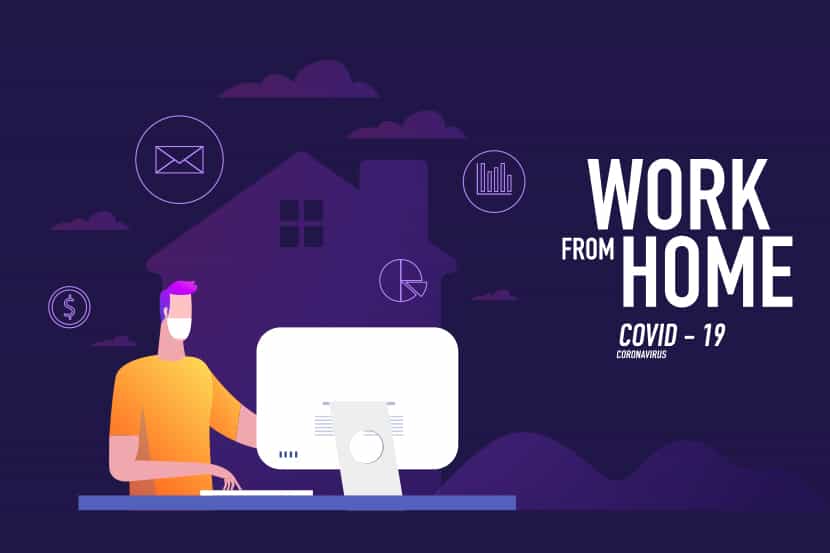How do you maintain security when employees work remotely, and your team is transitioning to a remote workforce?
As remote work is becoming a more prevalent trend in business and considering the recent COVID-19 outbreak, there’s no better time for employees and companies alike to make strides in securing remote work.
How to Secure Remote Access
This guide aims to instruct employees and management of businesses, both small and large, of the tools and steps available to them.
Employing only one of the following security measures will not be enough to thwart cyber threats. Each security measure, in isolation, will not guarantee secure remote work; however, when used in tandem with multiple measures, it creates a compounding effect for your cybersecurity.
Create a Cybersecurity policy for remote workers
If you allow remote work in your company, it is important to have a cybersecurity policy that ensures the security of all employees’ access to data. Create a policy that outlines the security protocol to be followed at home and on travel. Policies may include the expected use of approved messaging programs with encryption, such as Signal or WhatsApp; updating and patching computer security schedules, like updating antivirus or anti-malware software; and protocols on remotely wiping devices if lost.
Company-owned Devices
If your business has the means to give its employees laptops, you should consider it. This strategy is the best way to secure remote work because you can have your IT department manually configure firewall settings and install antivirus and anti-malware.
Conduct Regular Back-ups to Hard Drives
Any business is as good as its data. Most companies nowadays store data online on cloud storage services that are protected by encryption; although, regularly backing-up to a physical drive is also encouraged, as they cannot be hacked remotely.
Third-Party Vendors
Direct employees aren’t the only ones who risk compromising your company’s internal network. Third-party vendors are also responsible for creating entry-points into system infrastructure; therefore, your policy should extend to them as well.
Target’s data breach is an example of a breach caused by excessive privileges from third-party vendors. The Target example illustrates the need for organizations to reform their policy when issuing privileges to third-parties; otherwise, they may inadvertently create weak links in their security.
With third-party vendors in mind, you can gain a better understanding of your third-party environment by taking inventory of all vendor connections. Once you have an idea, it’s possible to increase your security by monitoring and investigating vendor activity through conducting session recordings and looking for any sort of malicious activity or policy violation.
Service-Level Agreements
Provide a third-party vendor with a service-level agreement (SLA). This option will force vendors to adhere to your organization’s security policies; otherwise, they face penalties.
Eliminate Shared Accounts
Inform your employees of the danger of unsecured Wi-Fi networks. If you use unsecured Wi-Fi on your phone, it is vulnerable to hackers who are looking to compromise the device. To prevent any unwanted intrusions, only use encrypted software to communicate.
It’s also best to restrict the use of applications on your mobile device when working. You can do this by delving into (app permissions).
Finally, turning off Bluetooth when working can limit paths to intrusion.
Network Border Protection your phone’s permission settings for applications For large businesses, network traffic can be filtered to process the flow of legitimate traffic and block potential intruders looking to exploit your network. You can use this filtering to analyze and block inbound requests from unauthorised IP addresses. These are inherent threats for your system. Inbound rules of your firewall can be configured to block incoming requests coming from unknown sources.
Select a Remote Access Software
Security is a major concern when telecommuting. You can choose between remote computer access, virtual networks, and direct application access. Choose the method that works best for your organization. Choose the method that works best for your organization.
Desktop Sharing

Remote PC access methods, such as desktop sharing, connect a remote computer to the host computer from a secondary location outside of the office. This setup means the operator has the ability to access local files on the host computer as if they were physically present in the office.
By logging in to third-party applications, an employee can turn a portable device into a display to access data on their office computer.
Even though the benefit of direct access exists, this kind of software carries a high risk of exposing the company’s internal network to danger because it creates an additional end-point for external threats to access the business’ local area network.
To combat potential risk, not only does the organization have to encrypt its firewalls and communications, the employee’s computer requires the same level of encryption. Depending on the size of your business, this option may be too costly to avail.
Applications such as LogMeIn, TeamViewer, and GoToMyPC provide this type of service.
Virtual Private Network
A virtual private network (VPN) is software that creates a secure connection over the internet by encrypting data. Remote workers can protect data transmissions by using tunneling protocols. These protocols encrypt and then decrypt messages sent from the sender to the receiver. There are usually two options when it comes to VPNs: IP Security Layer (SSL) or Secure Sockets Layer.
IPsec is manually configured and installed on the remote device. The operator will be required to enter details such as gateway IP addresses of the target networks as well as security keys to gain access to corporate networks. The employee can then download the VPN client from a target web page.
Direct Application Access
The least risky option for remote working is to directly access work applications. Employees can work remotely within specific applications instead of accessing the entire network. Due to the use of granular, perimeter applications on the network’s infrastructure, there are limited attack surfaces for susceptible data breaches.
Direct application access highly limits the risk of bad actors; in the same vein, it constricts work to the confines of one application. The amount of work that an employee can do is limited by the fact that they have little access to the entire network. Use Encryption
As important as it is to choose an access method for your online workers, it’s equally important those methods use encryption to secure remote employees’ data and connections.
Simply put, encryption is the process of converting data into code or ciphertext. Only those who possess the key or cipher can decrypt and use the data.
Encryption software is an added layer of protection for businesses and remote workers. For instance, if a remote employee’s computer is lost or misplaced, and a malicious actor recovers it, encryption software is the first line of defense in deterring unauthorized access.
Advanced Encryption Standard
As it stands, most businesses have the security protocol to use Advanced Encryption Standard (AES) to secure data due to its compatibility with a wide variety of applications. It uses symmetric encryption, which means the receiver will use a key to decode data sent by the sender. Look for encryption software that uses AES to secure company data. Look for encryption software that uses AES to secure company data.
End-to-end Encryption
When it comes to using things like email and software for general communication, look for applications that use end-to-end encryption, as it uses incredibly strong encryption that cannot be hacked if the two end-points are secure.
Implement a Password Management Software
Since most data breaches occur due to the use of illegally acquired credentials, password management software is an invaluable solution to remote work security.
Random Password Generation

Password management software does vastly more than just store passwords; it can also generate and retrieve complex, random password combinations it stores in an encrypted database. With this power, businesses can entirely reduce the use of the same or similar passwords.
Having all similar passwords has far-reaching consequences. If a malicious actor gets your username and password they can use them to login into other web properties or applications. It is a fact that humans are prone to reusing passwords with or without slight variations due to their limited memory. Unique strong passwords can eliminate this from ever happening and the rabbit hole of consequence that follows.
Automated Password Rotation
Additionally, password management software can entail automated password rotation. The name implies that passwords are reset constantly to limit their potential usage. By decreasing the lifespan of a password, sensitive data becomes less vulnerable to attack.
One-time-use Credentials
Another strategy you can utilize to protect your data with passwords is to create one-time-use credentials. Create a spreadsheet that acts as a safe for passwords. When a user creates a password to be used only once, they should mark it as “checked-out” in the spreadsheet. Once the task is completed, the user can check the password back in and retire the password.
Apply Two-factor Authentication
Authenticating the identity of a user is an essential aspect of access control. In order to gain access, one typically needs a username and a password. By using two-factor authentication you can improve remote work security. Essentially, it creates an added layer of login protection.
Two-factor authentication uses two pieces of information to grant access. This method uses credentials like username and password, along with a secret code or pin code sent to the user’s email or phone. This method makes it hard for malicious actors to access systems, as it’s unlikely they will have access to both pieces of information.
It is recommended businesses adopt this security measure for system log-ins.
Employ the Principle of Least Privilege
The Principle of Least Privilege (PoLP) is an effective method to mitigate security risk and limit the privileges of your workers.
Network security privileges come in three flavors: super users, standard users, and guest users, with diminishing privileges in that order. Guest users have no bearing in this discussion, however.
Superusers are those who have full access to system privileges. Superusers can make changes to a network, such as by installing or changing software, user data, or settings. When superuser accounts are misused, the worst can happen. Standard user accounts are also called the least-privileged users and have a restricted set of rights. This restricted account is the one you want your workers to use most of the time, especially if they don’t belong in your IT department.
As a precaution, we recommend having all employees use standard user accounts for routine tasks. Give superuser rights to only trusted members of your team. They should use these accounts for administrative tasks when necessary. This approach, known as the principle of least privilege, dramatically eliminates the risk of a severe data breach by limiting excess.
Remove Orphaned Accounts
Orphaned accounts are problematic because they are old user accounts that contain data encompassing usernames, passwords, emails, and more. These accounts are usually those of former employees who no longer have any connection with the company. These past employees may have moved on, but their accounts might still be on your network and remain accessible.
The problem is they are hard to see if your organization doesn’t know they exist. Orphaned accounts can be exploited by external or internal threats if they find them on your network. These attacks are called pass-the-hash attacks (PtH). These attacks are designed to use low-level credentials in order to gain access to your network. They then attempt to steal the hash of a password from an administrator account. The best way to remove orphaned and potentially dangerous accounts is to use a solution for managing privileged access. These tools can help locate and delete lingering accounts.
Create Employee Cybersecurity Training
Internal personnel represents a large share of the danger facing a company’s network security. In fact, just over one-third of all data breaches in 2019 occurred due to a malicious or negligent employee.
That doesn’t have to be the case. Instead, businesses can alleviate the danger of insider threats by cultivating a security culture through training employees on cybersecurity best practices.
Physical Security of Devices
To begin, secure remote employees by encouraging them to lock computers when traveling physically. When there is no physical access, the likelihood of malicious activity remains low. This phenomenon is called “shoulder surfing” and it’s more effective than you might think. This phenomenon is called “shoulder surfing” and is more effective than it seems.
Instruct employees to always log-off or shut down their computers when not in use. Leaving a computer on that is not password-protected is as effective for system entry as any malware attack.
Lastly, if passwords get written down on paper, have your workers rip-up these papers instead of merely throwing them in the trash.
Safe Internet Protocols
If your business is unable to provide laptops or computers with internet restriction applications to remote staff, you can set guidelines for best practices in safe browsing, installing pop-up blockers, and downloading of trusted applications for work.
Social Engineering Attacks
Malicious actors that use human psychology to trick people into giving sensitive information are called social engineers. These social engineering attacks come in multiple forms; however, the most common are called phishing attacks.
Hackers design these attacks to mislead employees to a fake landing page to steal information or install malware that they use to compromise network security. Phishing attacks are most commonly launched by unsolicited email. Therefore, train staff to never open unsolicited emails, click unknown links in messages and beware of attachments.
Secure Your Remote Workforce
In a globally decentralized business landscape, malicious actors will continually present a risk to business network security. Businesses must be aware of this threat and take precautions to secure remote work. For more in-depth instruction watch our expert present more on
:

https://www.youtube.com/watch?v=SvlzLcKlLgI
No matter the size of your business, there are affordable solutions you can exercise to protect your livelihood. Our experts can help you determine which option is right for your business. Contact us today to schedule a consultation. Hear one of our experts speak about the importance ofa.
Furthermore, learn about vulnerability assessment and vulnerability assessment tools to complete the process of securing your network.
